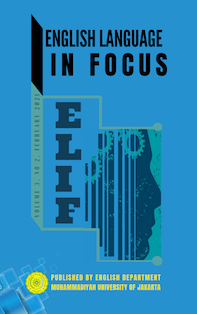Reading Comprehension Improvement through Question and Answer Relationship (QAR) Method
DOI:
https://doi.org/10.24853/elif.3.2.109-118Keywords:
question and answer relationship method, reading comprehensionAbstract
The objective of this research was to find out the significant difference in reading comprehension between students who were taught using the Question and Answer Relationship (QAR) method and those who were taught using the conventional method. This research used a quantitative approach with the experimental design of the quasi-experimental method. The instrument of this research was a test, dividing into pretest and posttest. In this research, it was found that the experimental group's mean pretest score was in a low category and the posttest score was in a good category. While the control group's mean pretest score was in a low category, but the posttest score was in the moderate category. The result of the Independent Sample T-Test indicated that the tcount was 4.549 which was higher than ttable (2.021) and the score of sig. (2-tailed) was 0.000 which was less than 0.05. This research thus concluded that there was a significant difference in reading comprehension achievement between students who were taught using the Question and Answer Relationship (QAR) method and those who were taught using the conventional method.References
Cohen, L., Manion, L., & Morrison, K. (2017). Research Methods in Education (8th ed.). Routledge.
Ernaini, Nurweni, A., & Suparman, U. (2018). Question Answer Relationship (QAR) In Teaching Reading Comprehension At SMPN5 Bandar Lampung. U-JET, 7(2), 1–8. http://jurnal.fkip.unila.ac.id/index.php/123/article/view/15133
Galvan, D. (2019). Active Reading Comprehension: A Dataset for Learning the Question-Answer Relationship Strategy. ACL 2019 - 57th Annual Meeting of the Association for Computational Linguistics, Proceedings of the Student Research Workshop, 106–112. https://doi.org/10.18653/v1/p19-2014
Izzah, L., & Hadi, M. S. (2018). Systemic Functional Genre on Students’ Reading Literacy. English Language in Focus (ELIF), 1(1), 35-44. https://doi.org/10.24853/elif.1.1.35-44
Kinniburgh, L. H., & Prew, S. S. (2010). Question Answer Relationships (QAR) in the Primary Grades: Laying the Foundation for Reading Comprehension. International Journal of Early Childhood Special Education, 2(1), 31–44. https://doi.org/10.20489/intjecse.107956
Mills, G. E., & Gay, L. R. (2016). Educational Research: Competencies for Analysis and Applications (11th ed.). Pearson Education Limited.
Muzammil, S. (2017). QAR (Question Answer Relationship) as an Alternative Strategy to Teach Reading. JL3T ( Journal of Linguistics Literature and Language Teaching), 2(2), 101–123. https://doi.org/10.32505/jl3t.v2i2.17
Nuriadi. (2008). Pembaca Teknik Jitu Menjadi Terampil. Pustaka Pelajar.
Raphael, T. E. (1986). Teaching Question Answer Relationships, Revisited. The Reading Teacher, 39(6), 516–522.
Raphael, T. E., & Au, K. H. (2005). QAR: Enhancing Comprehension and Test Taking Across Grades and Content Areas. The Reading Teacher, 59(3), 206–221. https://doi.org/10.1598/RT.59.3.1
Readence, J., Bean, T. W., & Bean, J. D. (2017). Content Area Literacy: An Integrated Approach (11th ed.). Kendall Hunt Publishing.
Sejnost, R. L. (2009). Tools for Teaching in the Block. In Tools for Teaching in the Block. California: Corwin Press. https://doi.org/10.4135/9781452219097
Stahl, K. A. D. (2004). Proof, Practice, and Promise: Comprehension Strategy Instruction in the Primary Grades. The Reading Teacher, 57(7), 598–609. https://www.jstor.org/stable/20205406
Suswika, W., Herlina, R., & Faridah, D. (2020). Question Answer Relationship (QAR) Strategy in Critical Reading on Narrative Text. JALL (Journal of Applied Linguistics and Literacy, 4(1), 95–102.
Thuy, N. T. B., & Huan, N. B. (2018). The Effects of Question-Answer Relationship Strategy on EFL High School Students’ Reading Comprehension. European Journal of English Language Teaching, 3(4), 34–48. https://doi.org/10.5281/ZENODO.1295713
Wiesendanger, K. (2001). Strategies for Literacy Education. Merrill.
Wilson, N. S., Grisham, D. L., & Smetana, L. (2009). Investigating Content Area Teachers Understanding of a Content Literacy Framework: A Yearlong Professional Development Initiative. Journal of Adolescent & Adult Literacy, 52(8), 708–718. https://doi.org/10.1598/jaal.52.8.6
Downloads
Published
Issue
Section
License
Authors who publish with this journal agree to the following terms:
- Authors retain copyright and grant the journal right of first publication with the work simultaneously licensed under a Creative Commons Attribution License that allows others to share the work with an acknowledgment of the work's authorship and initial publication in this journal.
- Authors can enter into separate, additional contractual arrangements for the non-exclusive distribution of the journal's published version of the work (e.g., post it to an institutional repository or publish it in a book), with an acknowledgment of its initial publication in this journal.
- Authors are permitted and encouraged to post their work online (e.g., in institutional repositories or on their website) before and during the submission process, as it can lead to productive exchanges, as well as earlier and greater citation of published work (See The Effect of Open Access).


